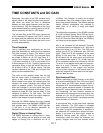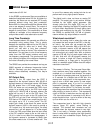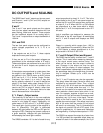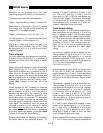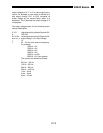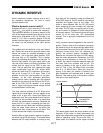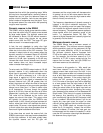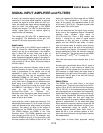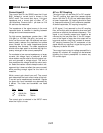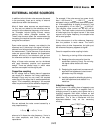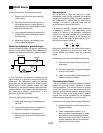
3-19
SR850 Basics
A lock-in can measure signals as small as a few
nanovolts. A low noise signal amplifier is required
to boost the signal to a level where the A/D con-
verter can digitize the signal without degrading the
signal to noise. The analog gain in the SR850
ranges from roughly 7 to 1000. As discussed pre-
viously, higher gains do not improve signal to
noise and are not necessary.
The overall gain (AC plus DC) is determined by
the sensitivity. The distribution of the gain (AC
versus DC) is set by the dynamic reserve.
Input noise
The input noise of the SR850 signal amplifier is
about 5 nVrms/√Hz. What does this noise figure
mean? Let's set up an experiment. If an amplifier
has 5 nVrms/√Hz of input noise and a gain of
1000, then the output will have 5 µVrms/√Hz of
noise. Suppose the amplifier output is low pass fil-
tered with a single RC filter (6 dB/oct roll off) with a
time constant of 100 ms. What will be the noise at
the filter output?
Amplifier input noise and Johnson noise of resis-
tors are Gaussian in nature. That is, the amount of
noise is proportional to the square root of the
bandwidth in which the noise is measured. A
single stage RC filter has an equivalent noise
bandwidth (ENBW) of 1/4T where T is the time
constant (RxC). This means that Gaussian noise
at the filter input is filtered with an effective band-
width equal to the ENBW. In this example, the
filter sees 5 µVrms/√Hz of noise at its input. It has
an ENBW of 1/(4x100ms) or 2.5 Hz. The voltage
noise at the filter output will be
5 µVrms/√Hz x√2.5Hz or 7.9µVrms. For
Gaussian noise, the peak to peak noise is about 5
times the rms noise. Thus, the output will have
about 40 µV pk-pk of noise.
Input noise for a lock-in works the same way. For
sensitivities below about 5 µV full scale, the input
noise will determine the output noise (at minimum
reserve). The amount of noise at the output is
determined by the ENBW of the low pass filter.
The SR850 displays the ENBW in the Time
Constant menu. The ENBW depends upon the
time constant and filter roll off. For example, sup-
pose the SR850 is set to 5 µV full scale with a 100
ms time constant and 6 dB/oct of filter roll off. The
SIGNAL INPUT AMPLIFIER and FILTERS
lock-in will measure the input noise with an ENBW
of 2.5 Hz. This translates to 7.9 nVrms at the
input. At the output, this represents about 0.16%
of full scale (7.9 nV/5 µV). The peak to peak noise
will be about 0.8% of full scale.
All of this assumes that the signal input is being
driven from a low impedance source. Remember
resistors have Johnson noise equal to
0.13x√R nVrms/√Hz. Even a 50Ω resistor has
almost 1 nVrms/√Hz of noise! A signal source
impedance of 2kΩ will have a Johnson noise
greater than the SR850's input noise. To deter-
mine the overall noise of multiple noise sources,
take the square root of the sum of the squares of
the individual noise figures. For example, if a 2kΩ
source impedance is used, the Johnson noise will
be 5.8 nVrms/√Hz. The overall noise at the SR850
input will be [5
2
+ 5.8
2
]
1/2
or 7.7 nVrms/√Hz.
We'll talk more about noise sources later in this
section.
At lower gains (sensitivities above 50 µV), there is
not enough gain at high reserve to amplify the
input noise to a level greater than the noise of the
A/D converter. In these cases, the output noise is
determined by the A/D noise. Fortunately, at these
sensitivities, the DC gain is low and the noise at
the output is negligible.
Notch filters
The SR850 has two notch filters in the signal
amplifier chain. These are pre-tuned to the line fre-
quency (50 or 60 Hz) and twice the line frequency
(100 or 120 Hz). In circumstances where the larg-
est noise signals are at the power line frequencies,
these filters can be engaged to remove noise sig-
nals at these frequencies. Removing the largest
noise signals before the final gain stage can
reduce the amount of dynamic reserve required to
perform a measurement. To the extent that these
filters reduce the required reserve to either 60 dB
or the minimum reserve (whichever is higher), then
some improvement might be gained. If the
required reserve without these notch filters is
below 60 dB or if the minimum reserve is suffi-
cient, then these filters do not significantly improve
the measurement.
Using either of these filters precludes making



